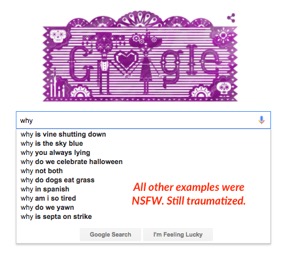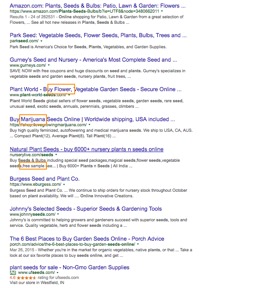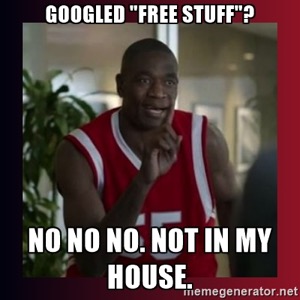Embracing The Dark Side Of Negative Keywords

I have been waiting for a long time to tell you about my dark side. I don’t want you to be scared and you don’t have to send a tweet of concern to @JeffAllenUT, but let’s talk about my love of negativity. Negative keywords, that is!
In this post we are going to talk about all things negative:
- What are negative keywords?
- How can we find negative keywords?
- How can we best use negative keywords to shape our account?
- Who is Negative Nancy and how can we change her outlook on life?

Basics Of Negative Keywords
Negative keywords are the liver of your paid search campaign. Much like the organ that cleans toxins from your bloodstream, negative keywords can purify your account of being shown in irrelevant ad auctions. Negative keywords, also like liver, taste great when they are breaded and served with onions.
Negative keywords let Google and Bing know which search queries you do not want to have trigger your ads. Having a list of negative keywords will result in more accurate customer targeting, higher click-through rates (CTR) and better Return On Investment (ROI). Negatives are especially important if you have broad or phrase match keywords in your account because broader matched keywords cast a wide net and can erroneously be attached to words that do not apply to your business.
Ideally, you have a list of keywords that are relevant to your business and customers are typing in these terms. However, the online world is unpredictable, with search queries that turn your keywords into innocent participants in irrelevant search queries.

Money is wasted is when ads are clicked, even though the search query shows that the viewer did not want your service. It is the biggest frustration of a paid search marketer to see people clicking on your ads when it clearly isn’t what they were looking for.
In an example for the maternity ward of a hospital, we added the names of celebrities that were in the news for their pregnancies to a negative keyword list to prevent our ads from being clicked accidentally. We also have negative keywords for pet pregnancy and obstetrician degrees and careers, which are not relevant to the hospital. Let’s save our money for the auctions that matter the most to us.
On The Hunt For Negative Keywords
Brainstorm With Your Team
A majority of your negative keywords can come from spending some time talking to your team about what erroneous words are linking to your product name or services. Maybe your customer support team can tell you common questions they hear, which they wish they didn’t have to answer. This might include some common negative keywords like visitors looking for free products or services or others looking for funny memes.

Additionally, there are some common words that the majority of companies can use to create negative lists to weed out traffic of general information seekers, job seekers, and bargain hunters. This blog post lists out the top 200 words to avoid.
Competitor Spying
Checking out the paid and organic results when you look up your product, your brand name, and your competitor names can open your eyes to possible negatives. For example, let’s say you own a company that sells fruit and vegetable seeds. Here are 3 potential negative keywords to add to your account.

Google Keyword Planner
While you are using the keyword planner to find words you want to start bidding on, take a minute to review some of the suggested words that don’t match your needs. For example, I have a client that sells a specific type of hydraulic pumps and without sufficient negative keywords, we could spend hundreds on visitors looking for products they don’t sell or service.
Search Query Reports
This is the goldmine of possible negative keywords. With a search query report, you can peek into the minds of the people that triggered your ad and start weeding out possible sources of misaligned traffic. I like to picture myself as a keyword Dikembe Mutombo.

How Can We Use Negative To Shape Our Account
There are general negatives that apply to all the campaigns in your account. These are negative keywords that you want to implement at the campaign level.
You can create a negative keyword list in the Shared Library section of your AdWords and Bing accounts to save time. You can even create multiple categorized lists to be used in multiple, if not all the campaigns. When new negatives are uncovered, you can update these shared lists and the changes will be applied to all the campaigns.
Additionally, within the campaign there might be keywords that are relevant to the whole campaign, but need to be filtered to just one ad group. This is when you need to set up negatives at the ad group level. For example, if you sell kids shoes and have a campaign with just boy shoe keywords, you want to make sure that when someone types in “boys sneakers,” that they aren’t getting served ads for boys boots. In this scenario, the word sneakers is a negative keyword in the campaigns for boots and vice versa. Here at Hanapin, we have a macro built by our Analyst team that helps us find these embedded negatives, but you can build a spreadsheet with your ad groups as column headers:

Last Pieces Of Advice
- Do not add all the negatives you can think of at once. Create waves of adding negatives and space out their additions every couple of weeks. Negatives might be too restrictive and could unintentionally choke good traffic, so monitor new negatives to make sure you aren’t Mutombo’ing quality traffic.
- Perform search query analysis regularly to find new keywords, negatives, and possible sources of overly aggressive negatives. Also, don’t forget to pull a large date range to make sure you are not eliminating seasonally significant traffic. If you want tips on how to perform a SQR, check out this webinar.
- Do not ignore the fact that some keywords may be poor converters but are not irrelevant and can contribute to assisted conversions. When performing SQRs, review their assisted metrics to make sure you are not about to negatively impact visitors in the research phase.
- Make sure your negative match types are set up correctly so you are eliminating the right search queries.

For instance, if I only sold the boyfriend arm pillow, I would want to have negatives for throw pillows. I could do a broad negative match type (-throw pillow) which would eliminate any time “throw” and “pillow” appear in a search query. Alternatively, I could do a negative exact keyword for –[throw pillow] which would only eliminate my ad for searches that are for ‘throw pillow’. Lastly, using a negative phrase of –“throw pillow” would eliminate the ads in searches that use those words together but may have other words in the search query, such as ‘boyfriend like substitutes for throw pillows’. For more in-depth guidance about negative match types, take a minute to read this post.
Final Thoughts
Negatives are a critical component to ensuring your account is not wasting money and your ads are being served to the most relevant of seekers. Whether you are new to paid search or have had campaigns running for years, setting aside time to review your keyword performance is a must. This activity will help you gain control over the sometimes unpredictable storm of search traffic and seek returns from the chaos of search marketing.



